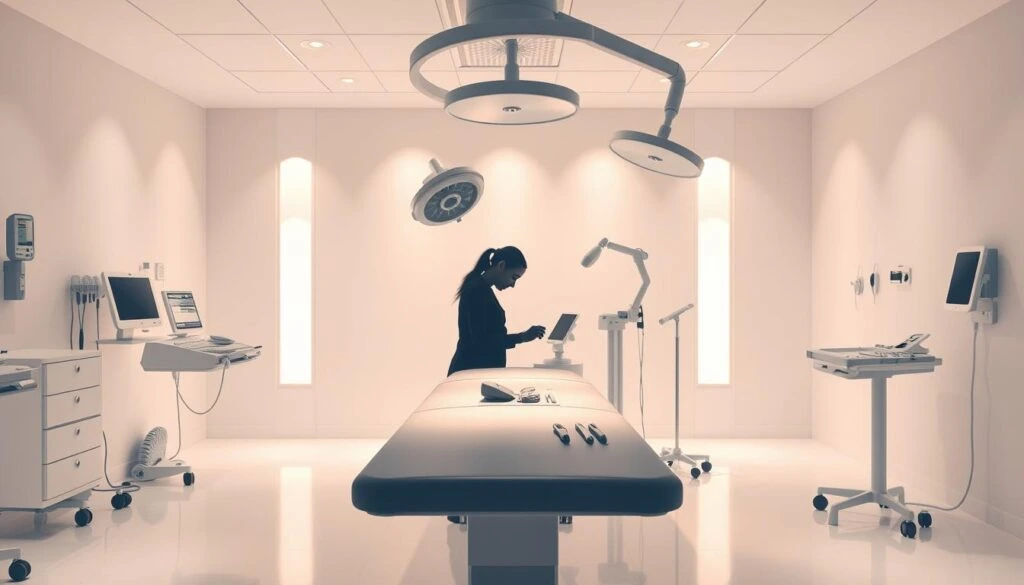Discover the optimal sleeping position after IUI to boost your chances of success. Learn essential tips and expert recommendations for post-procedure comfort and recovery
Going through an Intrauterine Insemination (IUI) is a big step in your journey to have a baby. But did you know that how you sleep after it can really help or hurt your chances? Sleeping the right way is key to helping your body get ready for implantation and boost your pregnancy hopes.
Want to know the best sleeping positions for your IUI treatment? This guide will show you how to sleep after IUI to increase your chances of getting pregnant.

Key Takeaways
- Proper sleeping position after IUI can enhance the chances of successful implantation
- Understanding the science behind IUI and its success factors is crucial
- Optimal supine (back) and side sleeping positions offer benefits for post-IUI recovery
- Avoiding certain sleeping positions and maintaining rest are key to maximizing IUI success
- Creating a comfortable sleep environment is essential for post-IUI healing
Understanding IUI Procedure and Its Success Factors
Intrauterine insemination (IUI) is a common fertility treatment. It involves placing sperm directly into the uterus during ovulation. This method aims to boost the chances of embryo implantation and successful pregnancy.
By grasping the science behind IUI and the elements that influence its success, those undergoing this treatment can make better choices. This can help them increase their chances of conceiving.
The Science Behind Intrauterine Insemination
A healthcare provider uses a thin, flexible catheter to insert the sperm sample into the uterus during IUI. This process helps overcome obstacles in the reproductive system. It ensures sperm reach the egg more easily.
By placing sperm closer to the egg, IUI boosts the chances of fertilization and embryo implantation.
Key Elements Affecting IUI Success Rates
Several factors can impact IUI success, including:
- Age of the female partner
- Causes of infertility
- Sperm quality and motility
- Timing of the insemination in relation to ovulation
- Number of follicles and their size
- Overall reproductive health of the couple
Timing and Preparation for the Procedure
Timing and preparation are key for IUI success. Healthcare providers use monitoring techniques to find the best time for insemination. They might also prescribe medication to help with follicle development and ovulation.
This can improve the chances of embryo implantation and successful fertility treatment.

Understanding IUI and its success factors helps individuals undergoing this iui procedure. They can work with their healthcare team to create a personalized treatment plan. This can increase their chances of a healthy pregnancy.
Sleeping Position After IUI: Essential Guidelines
After IUI, your sleeping position matters a lot. It can affect your fertility treatment’s success. By following these guidelines, you can help your embryo implant better and boost your chances of getting pregnant.
Optimal Sleeping Positions
The best sleeping position after IUI is on your back. This position keeps your uterus in the best shape. It also helps gravity move sperm towards the egg. Don’t sleep on your stomach or side, as they might not help implantation as much.
- Lie on your back with your legs slightly elevated, using pillows to support your knees and lower back.
- Maintain this supine position for at least 30 minutes after having intercourse during the fertility treatment.
- If you find it difficult to remain on your back throughout the night, try to spend as much time as possible in the supine position, especially in the hours immediately following the IUI procedure.
By choosing the supine position, you’re setting up the best chance for embryo implantation. This can greatly improve your IUI treatment’s success.

“Optimizing your sleeping position after IUI can make a significant difference in the success of your fertility treatment.”
Following these guidelines for sleeping after IUI is key to your post-treatment care. By focusing on rest and the right position, you support your body’s natural processes. This gives your fertility journey the best chance of success.
The Importance of Rest Following IUI Treatment
Going through intrauterine insemination (IUI) is exciting but also tiring. To boost your chances of a successful post iui care and pregnancy, rest is key.
Recommended Rest Duration
Healthcare experts say to relax for 24-48 hours after IUI. This lets your body focus on the embryo without stress. Try to sleep well, drink lots of water, and avoid hard work.
Signs You Need More Rest
- Persistent fatigue or exhaustion
- Increased cramping or discomfort
- Difficulty concentrating or focusing
- Emotional stress or anxiety
If you’re feeling any of these, your body might need more rest. Paying attention to your body and resting more can increase pregnancy chances after IUI.
Balancing Rest and Normal Activities
Rest is important, but getting back to normal slowly is good too. It keeps you feeling like yourself while waiting. Talk to your doctor to find the right mix of rest and activity.
Resting well after IUI helps your body support a healthy pregnancy. Remember, everyone recovers differently. Always talk to your healthcare team and listen to your body.
Optimal Supine Position for Post-IUI Recovery
The best sleeping position after IUI is lying on your back, or the supine position. This is because it supports the natural process of conception. It’s often recommended for post-IUI recovery.
The supine position is good for several reasons:
- Gravity Assistance: Lying on your back lets gravity help move sperm towards the uterus. This can improve the chances of successful implantation.
- Reduced Pressure: Being flat reduces pressure on reproductive organs. This makes a better environment for sperm to thrive.
- Minimized Leakage: The supine position prevents sperm leakage. This is key for the IUI procedure’s success.
To keep the optimal supine position, try these tips:
- Use pillows for your head and back to keep your spine aligned.
- Place a small pillow or towel under your knees for extra support and comfort.
- Avoid moving a lot while sleeping. It can disrupt the supine position and affect IUI success.
By focusing on the supine position and following these tips, you can help your body recover well after IUI. This increases the chances of a successful outcome.
Side Sleeping: Benefits and Considerations After IUI
If you’ve had intrauterine insemination (IUI), you might wonder about the best sleeping positions. Side sleeping is often recommended for recovery and better embryo implantation chances. It has many benefits and things to consider.
Left Side vs. Right Side Sleeping
Research shows that sleeping on your left side is best after IUI. It improves blood flow to the uterus, helping the embryo implant. It also reduces pressure on your digestive system, making it easier to digest food and absorb nutrients.
However, some people might find sleeping on the right side more comfortable. While it might not offer the same benefits, it can still be a good choice if you’re comfortable and aligned properly.
Supporting Your Body While Side Sleeping
To get the most out of side sleeping after IUI, make sure your body is aligned and supported. Use a body pillow or pregnancy pillow to keep your spine, hips, and knees straight. This can reduce pain and help you sleep better, which is key for healing and implantation.
| Benefit | Explanation |
|---|---|
| Improved Blood Flow | Side sleeping, especially on the left, boosts blood flow to the uterus, aiding embryo implantation. |
| Reduced Digestive Discomfort | Side sleeping relieves pressure on the digestive system, reducing bloating, heartburn, and other issues. |
| Enhanced Comfort | Using pillows for support makes side sleeping more comfortable, leading to better sleep quality. |
By adopting side sleeping after IUI and using the right support, you can boost your chances of successful implantation and pregnancy.
Elevated Hip Positioning Techniques
After an intrauterine insemination (IUI) procedure, how you sleep can help a lot. Sleeping with your hips up can help the sperm and embryo move towards the uterus. This might make getting pregnant easier.
Here are some tips to sleep with your hips up:
- Use Pillows Strategically – Put firm pillows under your hips. Make sure your lower back is supported too. This will gently lift your pelvis and keep your spine straight.
- Invest in a Wedge Pillow – Wedge pillows are made to support your body in a comfy way. They help create a slope to lift your hips while you sleep.
- Elevate the Bed’s Head – If your bed can be adjusted, lift the head. This makes a slope that lifts your hips as you sleep. It’s a good option for some people.
Keeping your hips up while you sleep can help the embryo implant better. This might make your IUI more likely to work. Try to find a sleeping position that’s comfy and keeps your hips up for the whole night.
| Sleeping Position | Potential Benefits | Considerations |
|---|---|---|
| Elevated Hips | – Assists gravity in moving sperm and embryo towards the uterus – May increase chances of successful embryo implantation | – Requires strategic use of pillows or wedge pillow – Ensure proper spine alignment and comfort |
Using these hip-lifting techniques after your IUI can help your body. It might make getting pregnant more likely.
Common Sleeping Position Mistakes to Avoid
After in vitro fertilization (IUI) treatment, it’s key to watch your sleeping position. This can help the embryo implant better. Some positions might lower your IUI success chances. We’ll look at common mistakes and sleep movement rules.
Positions That May Reduce Success Rates
Sleeping on your stomach is not good after IUI. It can press on the uterus and mess with implantation. Also, lying on your back for too long might not be best. It can cut off blood flow and mess with the uterus’s position.
Movement Restrictions During Sleep
- Avoid tossing and turning too much at night. It can upset the uterus’s delicate balance.
- Try not to move suddenly. It could knock the sperm or embryo off track.
- Don’t use big or thick pillows. They can make your body move in ways that aren’t good for implantation.
Being careful with your sleep can help your IUI treatment succeed. The aim is to keep the embryo in the best spot to grow.
The main thing is to rest well but sleep in a way that supports your IUI. Talk to your doctor for advice on sleeping right for your IUI journey.
Creating a Comfortable Sleep Environment Post-IUI
Getting a good night’s sleep is key after an intrauterine insemination (IUI) procedure. The quality of your sleep can affect the chances of a successful embryo implantation and conception. A comfortable sleep environment helps your body heal and recover, which can boost your post iui care and optimal sleeping positions. These are important for increasing pregnancy chances.
To make your bedroom perfect for rest after an IUI, follow these tips:
- Keep the room cool, between 65-70°F (18-21°C), for better sleep.
- Choose breathable, lightweight bedding to avoid heat and discomfort.
- Reduce distractions like bright lights, loud noises, and electronic devices to improve sleep.
- Try relaxation techniques like gentle stretching, deep breathing, or meditation to relax before bed.
A calm, sleep-friendly environment supports your body’s healing and can help with a successful IUI outcome. Remember, good sleep is a big part of your post iui care and fertility journey.
| Factors | Recommendations |
|---|---|
| Room Temperature | 65-70°F (18-21°C) |
| Bedding | Breathable, lightweight |
| External Stimuli | Minimize bright lights, loud noises, and electronic devices |
| Relaxation Techniques | Gentle stretching, deep breathing, meditation |
“A good night’s sleep is essential for the body’s natural healing and recovery processes, which can directly impact the success of an IUI procedure.”
Focus on your sleep environment and use relaxation techniques. This can help you create the best conditions for post iui care and increase pregnancy chances after your IUI treatment.
Physical Activities and Movement Restrictions
After an intrauterine insemination (IUI) procedure, knowing what physical activities to do and avoid is key. It helps support a successful fertility treatment and boosts pregnancy chances. By following these tips, you can help the embryo implant well and support a healthy pregnancy.
Safe Daily Activities
During the post-IUI recovery, you can do light, low-impact activities. These include:
- Light walking, such as short strolls around the neighborhood
- Gentle stretching or yoga poses that don’t involve excessive bending or twisting
- Engaging in relaxing hobbies or activities that don’t require significant physical exertion
- Maintaining a regular sleep schedule and getting adequate rest
Activities to Avoid
To ensure the best post iui care and pregnancy success, avoid these activities during recovery:
- Strenuous exercise, such as high-intensity workouts, heavy lifting, or jogging
- Engaging in activities that involve significant abdominal pressure, such as crunches or abdominal exercises
- Participating in contact sports or activities that pose a risk of physical injury
- Engaging in lengthy or rigorous household chores that may cause fatigue or discomfort
By sticking to these guidelines and focusing on post iui care, you can help the embryo implant well. This increases your chances of getting pregnant after the IUI procedure.
Conclusion
As you go through IUI treatment, it’s crucial to focus on sleeping positions and care after the procedure. Knowing how intrauterine insemination works and what affects its success rates helps a lot. You can then take steps to improve your chances of success.
Choosing the right sleeping position after IUI is important. You might want to try the supine position, side sleeping, or elevated hip positioning. These can help your body heal and support implantation. Also, getting enough rest and balancing it with daily activities is key for your well-being and fertility treatment success.
Every person’s journey is different, and it’s vital to work with your healthcare provider. By following the advice in this article and talking openly with your medical team, you can feel more confident. You’ll know you’re doing everything you can to increase your chances of success.
FAQ
What is the recommended sleeping position after an IUI procedure?
After an IUI, it’s best to sleep on your back with your hips up a bit. This helps the embryo implant better. It might increase your chances of getting pregnant.
How long should I rest after the IUI procedure?
Rest for 24-48 hours after the IUI. Avoid hard work and relax. This helps the embryo implant well.
Is it better to sleep on my left or right side after IUI?
Both sides are good, but left side might be better. It helps blood flow and embryo implantation.
How can I elevate my hips during sleep after IUI?
Use a wedge pillow or pillows under your back and hips. This keeps your hips up. It helps sperm and embryo move toward the uterus.
What activities should I avoid after the IUI procedure?
Avoid hard work like exercise and heavy lifting. Also, don’t have sex or take hot baths. These can harm your recovery.
How can I create a comfortable sleep environment after IUI?
Keep your room cool and use soft bedding. Try deep breathing or meditation before bed. A calm sleep space helps rest and implantation.
